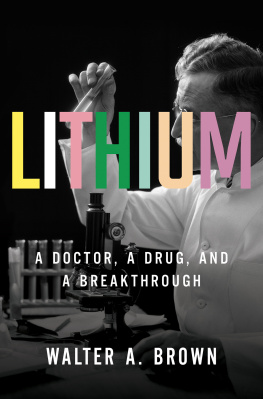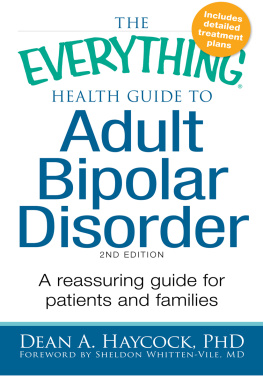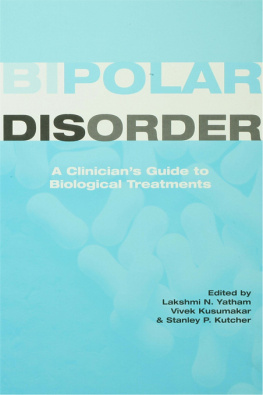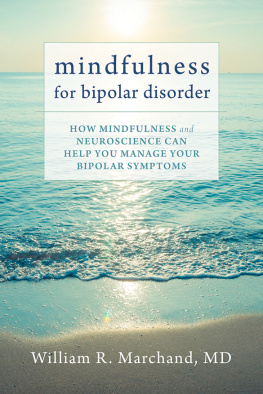Contents
Guide

LITHIUM

A DOCTOR, A DRUG,
AND
A BREAKTHROUGH
Walter A. Brown

LIVERIGHT PUBLISHING CORPORATION
A Division of W. W. Norton & Company
Independent Publishers Since 1923 | New York | London
Copyright 2019 by Walter A. Brown
All rights reserved
First Edition
For information about permission to reproduce selections from this book, write to Permissions, Liveright Publishing Corporation, a division of W. W. Norton & Company, Inc.,
500 Fifth Avenue, New York, NY 10110
For information about special discounts for bulk purchases, please contact
W. W. Norton Special Sales at specialsales@wwnorton.com or 800-233-4830
Book design by Brooke Koven
Production manager: Anna Oler
The Library of Congress has cataloged the printed edition as follows:
Names: Brown, Walter Armin, author.
Title: Lithium : a doctor, a drug, and a breakthrough / Walter A. Brown.
Description: First edition. | New York : Liveright Publishing Corporation,
[2019] | Includes bibliographical references and index.
Identifiers: LCCN 2019004546 | ISBN 9781631491993 (hardcover)
Subjects: | MESH: Cade, J. F. J. | Lithium Compoundshistory | Antimanic
Agentshistory | Lithium Compoundstherapeutic use | Bipolar
Disorderhistory | Bipolar Disorderdrug therapy | Antimanic
Agentstherapeutic use
Classification: LCC RC516 | NLM QV 77.9 | DDC 616.89/5061dc23
LC record available at https://lccn.loc.gov/2019004546
ISBN 9781631492006 (ebk.)
Liveright Publishing Corporation, 500 Fifth Avenue, New York, N.Y. 10110
www.wwnorton.com
W. W. Norton & Company Ltd., 15 Carlisle Street, London W1D 3BS
CONTENTS
LITHIUM
I N J ULY of 1968, I arrived at Yale, a newly minted doctor eager to start my specialty training in psychiatry. Back then, Freuds theories still dominated the field, and Yale was a veritable bastion of psychoanalysis. But I didnt learn much about psychoanalysis that year. What I did learn was not to approach Mr. G without first removing my necktie.
For the whole of that first year, I worked on a locked hospital ward, a place that housed the most severely mentally ill, and Mr. G was my first patient. A cherubic-looking 36-year-old, Mr. G had spent most of the last 17 years of his life in psychiatric hospitals, either immobilized by suicidal depression or in the throes of manic excitementelated, talking nonstop, constantly on the move, chock full of plans. When I took on his care, Mr. G had one big plan. He was going to Washington to meet with the president.
My job was to make sure that didnt happen.
Several times a week, Mr. G would make a rush for the door. Three nurses and I would drag him to a seclusion room where I would wrestle him to a mattress and a nurse would inject him with a sedative. Thats when I learned not to approach Mr. G without first removing my necktie; it was the first thing he would grab.
Mr. G suffered from manic-depressive illness, now more commonly known as bipolar disorder. The illness was officially renamed in the 1980 edition of the American Psychiatric Associations diagnostic manual; the manuals authors felt that the term bipolar was both more specific and less stigmatizing, manic being suggestive of the pejorative maniac. Recognized since the second century CE, bipolar disorder, with its frequent periods of depression and mania, is among the most devastating of psychiatric conditions. And Mr. G wasnt alone in his affliction. About 1 percent of the world populationincluding well over 2 million Americansendure this illness.
On a bright Tuesday morning in late November, as I rode my bicycle to the entrance of the hospital, I spotted Mr. G running across the parking lot on his way to the train station. Leaping off my bike, I managed to intercept him and convince him to come back to the ward. But his days there were numbered. His escape convinced the staff that Mr. G needed to be confined to a long-term facility, so he was transferred to the state hospital.
Two years later, after completing a research fellowship at the National Institutes of Health, I resumed my psychiatry training. Soon after, I ran into Mr. G, this time in the waiting room of a psychiatry clinic. Mr. G. brought me up to date on his situation. More than a year ago he had been released from the state hospital. Now he was living on his own and working as an assistant manager at a supermarket. His erratic behavior, emergency room visits, and hospital confinements were things of the past. He spoke with a combination of amusement and embarrassment about his single-minded determination to meet the president. Mr. G went on to tell me that a month before he left the hospital, he had started taking a drug that had just become available: lithium.
Now, more than 40 years after seeing how profoundly lithium changed Mr. G, I continue to be fascinated by its power.
Lithium, a light metal, is widely distributed on earth, with large amounts in rocks and seawater. Like the closely related metals sodium and potassium, when ingested, lithium readily enters cells throughout the body and takes part in cellular metabolism and other basic biological processes. Lithiums ability to fully alleviate the symptoms of a devastating condition makes it one of the best treatments in medicine. As again and again I saw the relief that lithium brought to my patients, I grew increasingly interested in how it worked and, in particular, how its remarkable effects were discovered. Over the years I gathered scattered bits of information, and each successive piece of the puzzle raised more questions. The original paper describing lithiums beneficial effects in manic patientswritten by an Australian psychiatrist named John Cadecame out in 1949, but the Food and Drug Administration (FDA) did not approve lithium for use until 1970. Why the 20-year hiatus? There was a general sense in the psychiatric community that lithiums discovery was a lucky accident, but was that true, or was a more systematic process at play? Most of all, I wanted to find out how an unknown Australian psychiatrist named John Cade managed to accomplish something so profound. Who was this man, and what were the circumstances that brought him to a groundbreaking moment?
I went in search of the story of John Cade and his remarkable discovery. A crucial experiment on guinea pigs prompted him to take lithium himself, and eventually he tested it in manic patients. Cades life brought him to the point whereequipped with neither research training nor research funding, working from a makeshift laboratory in an unused kitchen on the grounds of a small, isolated mental asylumhe set out to find the cause of, and cure for, manic-depressive illness.
In Cades day, the first half of the twentieth century, most doctors believed that people with a chronic severe mental illness had a disease that was largely hereditary and that involved a brain abnormality. Other than electroshock for depression, there were no effective treatments. The customary therapy for these patients was to confine them in asylums indefinitely or until the condition spontaneously improved. Drugs with stimulating or sedating properties, amphetamines, opiates, and bromides among them, were administered with little benefit and no effect on the characteristic symptoms of the illness. The idea that a drug alone could alleviate the symptoms of manic depression seemed far-fetched in the extreme.










